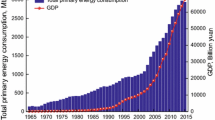Abstract
End-use energy consumption can reflect the industrial development of a country and the living standards of its residents. The study of end-use energy consumption can provide a solid basis for industrial restructuring, energy saving, and emission reduction. In this paper, we analyzed the end-use energy consumption of a region in Northwestern China, and applied the Markov prediction method to forecast the future demand of different types of end-use energy. This provides a reference for the energy structure optimization in the Northwestern China.
Similar content being viewed by others
References
Wang G, Xu Y, Ye C J. Analysis of the terminal energy structure evolution process in Zhejiang province[J]. Energy Engineering, 2015, (1): 26–30(Ch).
Chen T T. Research on Electricity Consumption Development Forecasting in Final Energy Consumption of Shanxi[D]. Beijing: North China Electric Power University, 2015(Ch).
Wan J, Zhou X B, Du Z. Correlation analysis and prediction of final energy consumption and economic growth in Hubei province[J]. Hubei Electric Power, 2015, (2):71–74(Ch).
Liu Z Y. Electric Power and Energy in China [M]. Beijing: China Electric Power Press, 2012(Ch).
Zhang H, Wang F L, Suo R X. Forecasting the industry structure of the east, the middle and the west based on Markov model[J]. Mathematics in Practice and Theory, 2010, 40(7): 39–44(Ch).
Tang X W, Zeng Y. The estimation of transition probability of Markov chains in market forecasting[J]. Journal of UEST of China, 1994, (12): 643–648(Ch).
Vassiliou P C G, Vasileiou A. Asymptotic behaviour of the survival probabilities in an inhomogeneous semi-Markov model for the migration process in credit risk[J]. Linear Algebra and Its Applications, 2013, 438(7): 2880–2903.
Zhou Y, Li Z. The application of Markov skeleton process on the infectious disease management model [C] // International Conference on Artificial Intelligence, Management Science and Electronic Commerce. Washington D C: IEEE, 2011: 2477–2480.
Zhou Y, Fan H. The application of Markov skeleton process on the population forecast[J]. Journal of Convergence Information Technology, 2012, 7(19): 373–380(Ch).
Zhang H, Zhang W, Palazoglu A, et al. Prediction of ozone levels using a hidden Markov model (HMM) with Gamma distribution[J]. Atmospheric Environment, 2012, 62(15): 64–73(Ch).
He Y, Pu Y, Wang J, et al. Spatial-temporal dynamics of Sichuan industrial structure with Markov chains approach[J]. The International Conference on Geoinformatics, 2010, 2(1): 1–6.
Leithon J, Lim T J, et al. Renewable energy management in cellular networks: An online strategy based on ARIMA forecasting and a Markov chain model [C] // Wireless Communications and Networking Conference. Washington D C: IEEE, 2016: 1–6.
Xie H, Yang L, Wang J, et al. Short-term power forecasting for photovoltaic generation based on wavelet neural network and residual correction of Markov chain [C] // IEEE Pes Asia-Pacific Power and Energy Engineering Conference. Washington D C: IEEE, 2016: 1–5.
Ding K, Feng L, Wang X, et al. Forecast of PV power generation based on residual correction of Markovchain [C] // International Conference on Control, Automation and Information Sciences. Washington D C: IEEE, 2015: 355–359.
Author information
Authors and Affiliations
Corresponding author
Additional information
Foundation item: Supported by the National Natural Science Foundation of China (71471059)
Biography: YANG Xing, male, Ph. D. candidate, research direction: power economic management.
Rights and permissions
About this article
Cite this article
Yang, X., Kang, H. & Niu, D. Prediction of end-use energy consumption in a region of Northwest China. Wuhan Univ. J. Nat. Sci. 23, 25–30 (2018). https://doi.org/10.1007/s11859-018-1290-5
Received:
Published:
Issue Date:
DOI: https://doi.org/10.1007/s11859-018-1290-5




